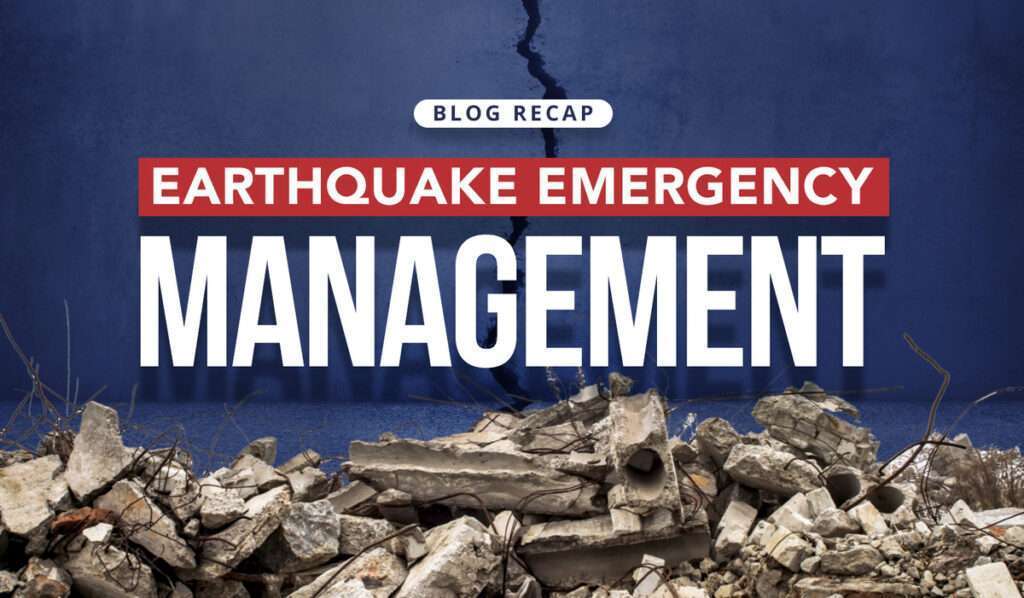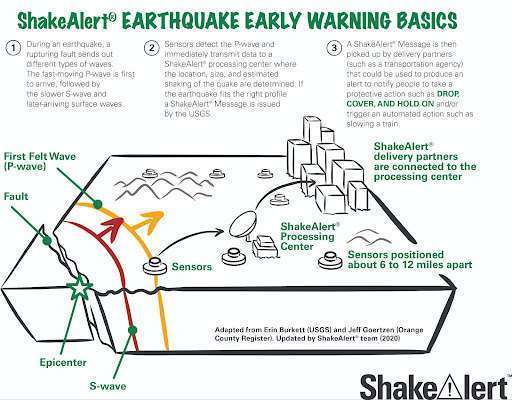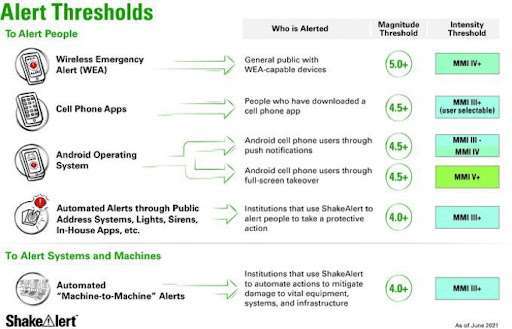
Shake Up Your Earthquake Preparedness Plan
In today’s unpredictable world, self-sufficiency in the face of natural disasters, particularly earthquakes, is not just a luxury but a necessity. When disaster strikes, first responders may not always be readily available to lend immediate assistance. Therefore, a well-structured and proactive plan that equips you for such adversities can significantly expedite your recovery and that of the community.
Businesses are essential to the community’s recovery and must also prepare to continue operating during and after an earthquake. Recognizing that employees are the backbone of any organization, it becomes paramount for every individual within a company to be well-informed and proficient in an organization’s preparedness plan. After all, their well-being and safety are directly intertwined with the success and continuity of the business.
To effectively tackle any disaster, it is crucial to begin understanding the risks and formulating strategies to safeguard your valuable assets. In the specific context of earthquakes, the primary tremors often trigger secondary effects like landslides, fires and floods, amplifying the potential for damage and destruction. Hence, a proactive approach to identifying and preparing for these risks becomes imperative.
As we embark on a journey towards comprehensive disaster preparedness, this article sheds light on the critical aspects that demand our attention. By delving into earthquake preparedness, we can empower ourselves and our communities to confront the imminent challenges posed by these seismic events. Together we can fortify our resilience and build a safer future.
The next “big one”
There are thousands of earthquakes worldwide each year, but most are small or occur in unpopulated areas. Typically, we hear about the ones that create damage. Within the U.S., Alaska takes the lead as the state experiencing the highest number of seismic events, followed by California and the Pacific Northwest. A staggering 73% of the annual $6.1 billion earthquake damages in the U.S. occur in the West Coast states of Washington, Oregon and California, as estimated by FEMA.
However, California has the most seismic risk due to its population and infrastructure. California has an average of 30 to 50 earthquakes a day, but most are too small to feel. At any time, there could be an M (magnitude) 4, M5, M6, M7 or M8 earthquake.
The M6.7 1994 Northridge, California earthquake, remains the most recent significant earthquake to have affected a densely populated area (the greater Los Angeles region) in Southern California. As experts aptly suggest, the notion that “we are as close to the next one as we are far away from the last one” highlights the current period of relative seismic calm in Southern California.
On average, there is a major damaging event on the San Andreas Fault between every 30 and 200 years, with an average of every 150 years. It is not if but when California and the Pacific Northwest will experience another large seismic event, and this is what we need to prepare for. If we are prepared for the “Big Ones,” we will be ready for the smaller events.
How to prepare for an earthquake
It has been some time since the last large event (an earthquake with an M7.7 or above) damaged a populated area in the Western states. Scientists have built models based on the existing infrastructure and population on understanding how Southern California counties will be affected by the next large earthquake.
For example, emergency planning officials know from a M7.8 earthquake model made on the southern portion of the San Andreas Fault that a large earthquake will affect eight counties in Southern California. So, they plan for additional emergency response resources from outside the area.
They also plan for significant damage to an estimated 300,000 buildings throughout Southern California, although these buildings will likely not fall entirely like other places in the world due to more sound building codes in California. In addition, experts estimate water, power and communication loss and disruptions in service for millions,1,600 ignitions of fires and up to 270,000 people displaced for long periods.
Statistics show that if you prepare for an earthquake disaster, your recovery will be significantly faster—you will be part of the solution and not part of the problem.
Measures you can take to prepare yourself for an earthquake include:
- Storing and keeping water on hand for when water lines break or a loss of electricity that pumps water to businesses and households—one gallon per person per day for at least seven to fourteen days or two cases of bottled water for one person for two weeks.
- Planning for electricity outages to keep businesses and houses running. Stocking fuel for generators or having solar-powered lights stocked.
- Creating a backup communication plan for when cell towers are down. Have an emergency contact set up within families and businesses outside the damaged area.
- Having unexpired fire extinguishers on hand in the house at all times. During and after an earthquake, place one on the street’s curb, so in case aftershocks spur fires in your neighborhood, people can easily extinguish a small fire before it grows and before first responders arrive.
- Create an emergency kit and travel bag ready for a quick evacuation, and keep one in your car, at home and work.
- For businesses, know where your employees live to see if they can get to and from work and are safe at home. If prepared at home, they can return to work faster to keep the business door open.
- Have one point of contact for all communication.
Additional earthquake preparedness resources
- More ways to prepare your home for an earthquake can be found at the Earthquake Country Alliance’s “Seven Steps to Earthquake Safety.”
- FEMA’s Individuals and Households Program (IHP) provides financial and direct services to eligible individuals and households affected by a disaster. https://www.ready.gov/.
- For earthquake drills to practice and how to be safer during earthquakes: https://www.shakeout.org/.
ShakeAlert® Earthquake Early Warning System
The ShakeAlert® Earthquake Early Warning system, managed by the U.S. Geological Survey (USGS) along with university and state partners, quickly detects significant earthquakes, estimates shaking and issues ShakeAlert Messages to Technical Partners. Then, Technical Partners, which have entered into a license agreement with the USGS, use this information to deliver alerts that rapidly reach people and trigger automated actions to protect vital systems and infrastructure, potentially seconds before shaking arrives at their location. The ShakeAlert system serves over 50 million people in California, Oregon and Washington, representing the three states with the highest earthquake risk in the U.S.

There are several ways to get ShakeAlert-powered alerts on your cell phone (Note: The USGS does not directly or indirectly endorse any product or service provided, or to be provided, by these alert delivery providers).
- The MyShakeTM app was developed by UC Berkeley and is sponsored by the California Governor’s Office of Emergency Services. MyShake is available for free in the Apple iTunes and Google Play stores – more information is available here. MyShake is currently operating in California, Oregon and Washington.
- The QuakeAlertUSA app is a product of Early Warning Labs, LLC in collaboration with state and federal government agencies and academia. QuakeAlertUSA is available for free on the Apple iTunes and Google Play stores and is currently operating in California and Oregon—more information on QuakeAlertUSA.
- Google provides a ShakeAlert-powered earthquake alert feature that is integrated into the Android Operating System. This service is available in California, Oregon and Washington on cell phones using the Android operating system.
- ShakeReadySD is the ShakeAlert-powered Earthquake Early Warning component of the San Diego County Emergency app. ShakeReadySD only delivers alerts to phones in California. SD Emergency can be downloaded for free on the Apple iTunes and Google Play stores.

The goal of the ShakeAlert system is to warn people of an earthquake as quickly as possible so that people can take action as quickly as possible. The ShakeAlert System is a powerful tool to alert people to take action sooner than when they feel the earthquake, so they can prepare and take action for its impact.
Using Regroup Mass Notification to prepare and protect businesses and people during an earthquake
Like the ShakeAlert Earthquake Early Warning System, the speed at which an emergency alert is issued can make all the difference in allowing people to prepare for an earthquake. When emergency managers promptly provide alerts and notifications, they effectively prevent panic and give more time for people to prepare for an earthquake’s impact.
A mass notification system like Regroup’s is an indispensable tool to prepare people for earthquakes as quickly as possible. By harnessing the power of emergency alerts and mass notification systems, community members, employees, students and first responders can swiftly receive crucial information about the situation unfolding in their area. From which areas to avoid to important emergency steps, these systems play a vital role in keeping everyone informed and safe.
Regroup Mass Notification can provide earthquake notifications after an event for situational awareness but is currently not offering earthquake early warning products and services that are powered by data from the USGS managed ShakeAlert System . With Regroup Mass Notification, warnings for awareness can be quickly communicated to mobile devices, landlines, email, social media and websites, effectively alerting entire communities and providing vital emergency response information. Regroup provides a fast, robust message throughput of up to 80,000 text/SMS messages per minute, which exceeds the messaging capabilities of most mass notification systems. Additionally, these emergency alerts can be sent to a specific area using GeoFencing technology.
Regroup mass notification partners with other early warning systems, such as the National Weather Service (NWS), The Federal Emergency Management Agency’s (FEMA) Integrated Public Alert & Warning System (IPAWS) and The National Oceanic and Atmospheric Administration (NOAA) to help prepare people for impending earthquakes and other severe weather. Regroup’s automated severe weather notifications send emergency alerts with updated information regarding important safety measures, evacuation orders and immediate dangers. Alerts are successfully delivered even when power lines are down due to Regroup’s redundant, cloud-based platform.
Although Regroup is an effective crisis communication system, notifications are also useful to support existing emergency preparedness plans. For example, non-critical messages can be sent throughout an organization to inform people of important updates on emergency plans or drills. Regroup also offers unlimited administrators to manage communications to specific groups. In addition, Regroup integrates with many existing systems and processes currently being used within an organization and community, including built-in emergency alarm systems, digital signage, work-sharing software and employee record databases.
When preparing for an earthquake, the Regroup Mass Notification system takes the lead in sending critical emergency alerts.
To learn more about how to prepare for an earthquake, view our recorded webinar, “Earthquake Emergency Management” To learn more about how Regroup can better prepare your residents, employees, community and students, visit www.regroup.com.